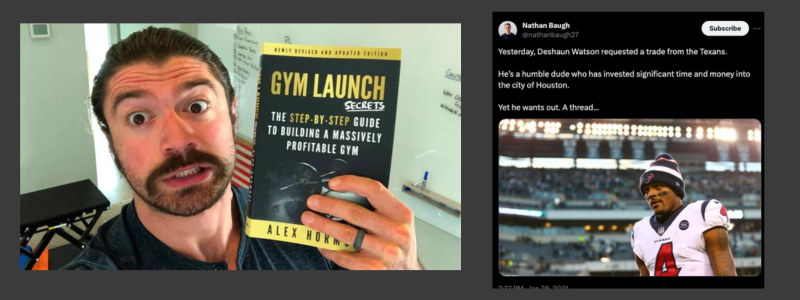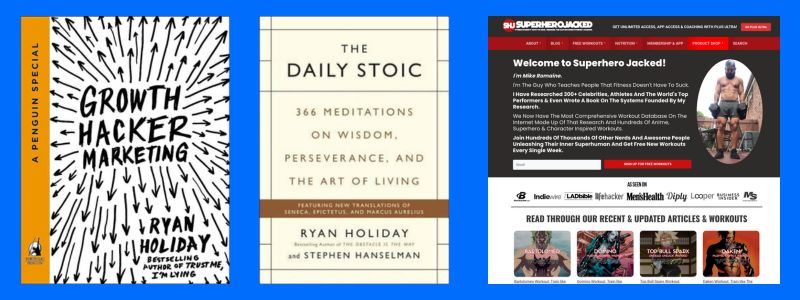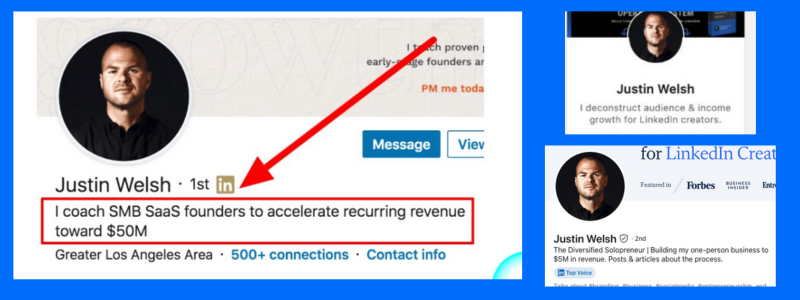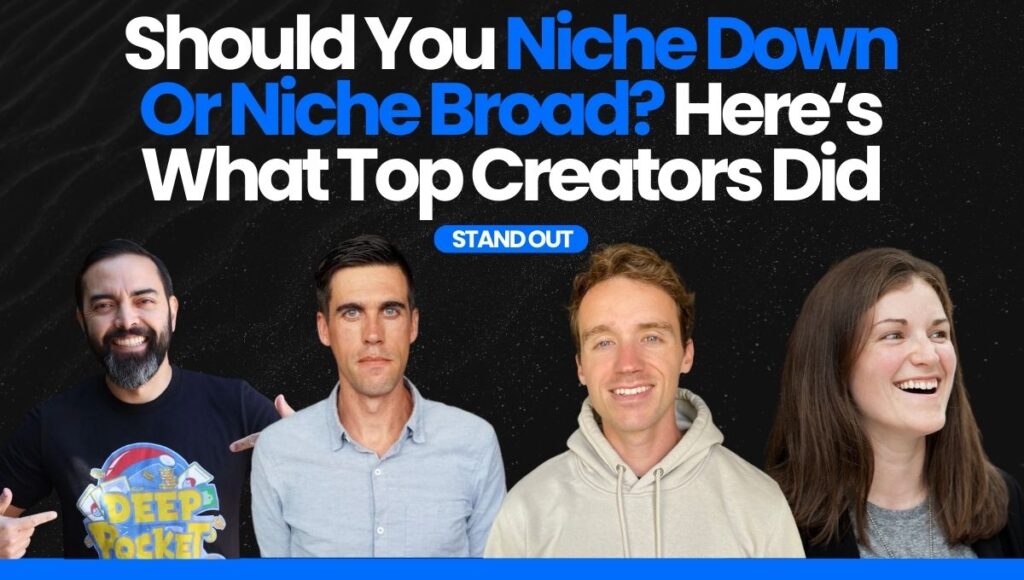For this case study I'm going to be doing things slightly different than normal.
We'd normally take a look at 4-5 creators and discuss a specific topic, but for this one I want to take a look at TEN creators, narrowing down the niche discussion to 5 specific areas.
The topic of Niche Down VS. Niche Broad is one that books have been written about, so I'm surely not going to take on the enormous task of trying to sort it all out for you in one article.
That said, I AM going to give you massive insight into niching down, and how you can still niche down without niching yourself out of a market, AND brand wide for future growth.
At the end I will also tie this all back to my perspective, and how I have both taught this, and used this coming into my own personal brand.
Here are the niche areas I will be diving into with 2 creator case studies for each:
- Pivoting Out Of An Original Niche
- Niching Down Multiple Layers
- Niching Down Branding Wide [for Growth]
- Branding Wide At The Start
- Niche (but not TOO Niche) At The Start
If those topics don't make complete sense now, they will when we get into specific examples, so stick around because these are some of my favorite creators.
We'll be taking a look at:
- Alex Hormozi
- Nathan Baugh
- Ryan Holiday
- Superhero Jacked
- Justin Welsh
- Ramit Sethi
- Jade Bonacolta
- Ben Meer
- Pat Flynn (Deep Pocket Monster)
- Chenell Basilio (Growth In Reverse)
You may recognize a lot of these names (and you probably should).
But the key for this one is the fact that I don't want to just look at where these creators are now...
Too many people see these larger creators with massive brands that are extremely broad, but neglect to see where they started out early on.
I have my own specific opinions on the topic overall, but I will be doing my best to save that for the end, and remain unbiased (I mean...I'll TRY..) while sharing each creator and topic.

 Pivoting Out Of An Original Niche: Alex Hormozi and Nathan Baugh
Pivoting Out Of An Original Niche: Alex Hormozi and Nathan Baugh
To start this one off I do want to point out that I am in this boat in a way, going from Superhero Jacked to Science Based Marketing (and I will touch on that below), but I want to highlight these two specific examples for a couple different reasons.
I'm starting here specifically because I think Alex Hormozi is one of the most prominent examples of people seeing a massive brand, but forgetting where the creator came from.
And then, to bring us back down to a big (yet not massive) creator, Nathan Baugh is such a good example of exploration and pivoting completely out of a niche.

If you are a fan of Alex Hormozi you have probably seen him share his thoughts on teaching before doing.
Here are some quotes from his social feeds:
- "Advice to 20 year olds: Do shit before teaching how to do shit."
- "Hot take: You shouldn’t sell advice for things you haven’t done."
- "Don’t fake it until you make it. Make it - then state the facts."
- "You’re not struggling from imposter syndrome. You’re a student and pretending to be a teacher. No students say they feel like frauds for trying to learn. You’re a fraud when you get up to teach the class and you’ve never done it."
Alex Hormozi didn't always have a personal brand with a massive, wide audience.
Actually, he started by owning a handful of gyms.
Then he met Russell Brunson and Russell told him he was in the wrong niche.
Instead of learning to sell more packages at his own gyms, he should be teaching other gym owners to sell more packages at THEIR gyms.
Which was the birth of Gym Launch.
Alex Hormozi started extremely niche.
His audience was very specific to gym owners.
From there he made millions and millions of dollars, eventually selling the business for $50M, and deciding to pivot into his personal brand because he decided that was the best way to expand his reach and help more people.
So before you think Alex Hormozi is branded wide for growth, stop to think back to where he started.
Here's a specific image he shares in his book $100M Offers that shows a bit of how he feels about niching down.

We can niche down to:
- Stand out.
- Specialize.
- Charge more.
So while I want to be unbiased throughout this case study, I also have to acknowledge the power of niching down.

Though our next example is going to be quicker, I think it's super important to take a look at and recognize within our full case study.
I'd go as far as saying that this specific case study is likely going to be the most popular route for the majority of creators.
If we look back to where Nathan Baugh started we can actually see he started with content and a newsletter focused around sports analyzing.
His first thread on Twitter that we can look back to is the one I shared above, breaking down a trade in the NFL.
His newsletter at the time was "Sideline Sprint".
That post I shared was January of 2021.
Fast forward to 2022 and Nathan was able to find where he REALLY wanted to be niched into: storytelling (business sub-niche).
Now Nathan has a newsletter called World Builders and has amassed a huge following of 250,000 on Twitter and 100,000 on LinkedIn.
This was a hard pivot out of one niche and into another, but not necessarily selling his old brand like Hormozi or even leveraging it in a way that drives more leads - but rather having used it to discover his true niche.
*Bonus Note: A lot of people make the argument that you won't be able to find your niche if you start niche, but that isn't the case. As you can see with Nathan, you can start niche, start creating, and it can still lead you to a much different niche down the road.

 Niching Down Multiple Layers: Ryan Holiday and Superhero Jacked
Niching Down Multiple Layers: Ryan Holiday and Superhero Jacked
In an attempt to not talk about myself too much I refrained from including myself in that last example, although I do think I would have been a perfect addition.
(I didn't hard pivot by selling and I didn't hard pivot by moving on from one to the other completely, but I DID hard pivot while still running Superhero Jacked).
I will discuss more of that below, because before I go too deep there, I want to dive back 10 years earlier to the early days of Superhero Jacked and discuss niching down multiple layers.
For this one I am also going to be talking about Ryan Holiday, who is also very niche in what he does, but I am going to be using him as the example of someone who started extremely broad and then found the magic in going niche.
Note: Ryan and Justin are also my favorite examples on this list of being associated with a specific word, or being known for one thing.

Ryan Holiday actually started in digital marketing.
Now he is known for one specific thing: Stoicism.
He has become associated with that word.
You hear Ryan Holiday, and you think Stoicism.
And I'd dare go out on a limb here and say it's pretty darn niche!
So if we look at the massive brand he has now built around Stoicism it may be easy to assume he started there and over time built a big brand, but in reality it took some searching, similar to Nathan Baugh's story, and he ultimately decided to niche down more than just marketing.
Being associated with one specific thing can be extremely powerful.
- Ryan Holiday = Stoicism
- James Clear = Habits
- Codie Sanchez = Boring Businesses
- Justin Welsh = Solopreneurship
- Nick Huber = Sweaty Startups
Ryan Holiday's actually career entirely changed with a single blog post.
Ryan had published both "Trust Me, I'm Lying" and "Growth Hacker Marketing" thinking his niche was digital marketing, until one day a simple blog post went viral.
The article "Stoicism 101: A Practical Guide for Entrepreneurs" went viral on his blog, and he then received a call from his publisher about expanding on the topic.
Which turned into his first book on Stoicism: "The Obstacle is The Way" and became the turning point of his entire career.

For Superhero Jacked my journey was similar, but different.
I actually niched down not once, but twice along the way, each time leading to more volume.
I actually niched down not once, but twice, each time leading to more volume.
Yes, you read that right.
I'll repeat it for dramatic effect:
I niched down into a smaller audience (twice) and it lead to more volume.
To start my journey I knew I wanted to be in the fitness industry, but I wasn't sure if I wanted to niche down.
I was hesitant like many other people are.
I thought niching down meant losing some sales, but instead, by not niching down I was losing ALL the sales.
I started in broad fitness niches, with a few different websites, just none ever really taking off.
Then, when I finally decided it was okay to let out my inner nerd and be myself, that's when the magic happened.
I started Superhero Jacked niched into the fandom and fitness category, but really focused on celebrity workouts and diets, doing case studies on all of the celebrities that got in great shape for superhero roles.
I started as just a jacked personal trainer with a few certifications and borrowed an authority to become an authority in the fitness industry.
Fast forward four or five years and there was massive competition in the celebrity fitness niche, as more and more people caught on to how many people were searching for it on Google (and interested in it overall).
And yes, of course I miss the days of a Blue Ocean niche that was virtually untapped!
I had tested superhero and anime inspired workouts with my list, that was already quite large at the time, and they had done well...BUT, no one outside of my list knew you could Google character workouts...because they didn't exist...
So I had a decision to make: Do I go more broad and add layers to the business that I don't necessarily love (making it more of a personal brand, adding in video, etc.), or do I niche down even deeper into the fitness X fandom niche?
I ultimately chose the fitness X fandom niche for a few reasons:
- I knew going into Superhero Jacked (even 10 years ago) that I didn't want to be "the fitness guy" forever, and would eventually pivot into a personal brand elsewhere.
- I didn't love the broad fitness industry, but loved helping the community I was in within the Fitness X Fandom niche.
Which may make it seem like the decision was easy, but in reality it was: Proven niche with a larger earning potential VS. Unproven completely random niche.
Fast forward another 3-5 years and niching down each time led me to even more volume and more sales, and now I make multiple six figures a year while working just 10-20 hours a week.

 Niche Down, Brand Wide [For Growth]: Justin Welsh and Ramit Sethi
Niche Down, Brand Wide [For Growth]: Justin Welsh and Ramit Sethi
The next topic we're going to take a look at is slow growth into much larger and broader brand.
This is especially important for people who think they can't niche down because they may get locked into their niche.
This couldn't be further from the truth.

Coming in from the point of being known for one thing, Justin Welsh is seen as a thought leader and known for Solopreneurship.
But he didn't start that way.
Actually, Justin was originally considering going a completely different route when he first started building his following and growing on LinkedIn.
If we take a look at Justin's past headlines from his LinkedIn profile it actually tells us a story of his growth over time.
- Justin started extremely niche, with his headline originally reading "I coach SMB SaaS founders to accelerate recurring revenue toward $50M", and was even doing consulting.
- From there Justin began pivoting into LinkedIn growth, with his headline reading: "I deconstruct audience and income growth for LinkedIn creators."
- Now we can see Justin's headline reads: "The Diversified Solopreneur | Building my one person business to $5M in revenue. Posts and articles about the process."
There's obviously much more to the story, but what we really need to learn from this is that we may see this massive thought leader who seems to have an extremely all encompassing brand, but in reality he started extremely niche and slowly grew into where he is today.

Similar to Justin, Ramit Sethi of I Will Teach You To Be Rich has grown into a massive brand.
Ramit is a NY Times Bestselling author and even recently had a show on Netflix!
And while Ramit's brand started hyper-focused in finance (and that is where his book and most of his content still points; including the Netflix series), Ramit has now grown into many different products and offers.
Instead of strictly selling products on saving money and investing, Ramit slowly grew into products teaching people how to increase their income, including building their own online business.
We have seen other examples of this all over the internet, and you may not have even noticed it.
Another quick example right off the top of my head would be something like this:
ComicBook.com: They may have started by thinking they were just going to write about comic books but now you can find just about everything under the sun related to fandoms, video games, and more.
And Ramit, Justin and even a brand example of ComicBook.com are just a few of the many examples of being able to start niche and slowly grow into a much larger brand.

 Brand Wide At The Start: Ben Meer and Jade Bonacolta
Brand Wide At The Start: Ben Meer and Jade Bonacolta
Branding wide for growth at the start can be an answer for some people.
In this next section I'm going to be covering two creators that branded wide for their audience and grew massive brands across multiple different platforms.
The thing I want to focus on here is the route to monetization. It's not as clear as some of the other paths, but could also be intentional depending on your own personal journey.
I'll cover both sides of this with each creator.

Ben Meer has amassed an enormous following over the course of about a year and a half to two years time.
Between LinkedIn, Twitter and Instagram I believe he is now pushing 2 million followers, which is just out of this world enormous.
And while his newsletter is fairly niche in the sense that he keeps it to specific systems, "System Sunday", his content is fairly broad to be able to reach this growth.
Ben shares very broad content that is build around personal development (as he writes right there in his bio on LinkedIn), sharing posts ranging from systems, to his favorite websites to increase productivity, to Ted Talks, books and much more.
But what does he sell?
Ben has newsletter sponsors for his enormous list, and he also sells his digital course "Creator Method" that teaches people to grow on LinkedIn, Twitter and Instagram, as well as one on one coaching consultation sessions.
This is what I specifically want to make note of.
Ben is niched into personal development and systems, but he is actually selling content growth.
I want to analyze that specifically because if you aim for growth and stay broad you need to think about how that effects your offer.
Remember what we talked about before when we discussed Alex Hormozi and how he recommends increasing the price of your offer by niching down?
Well broad is usually the opposite approach that you want to take.
So if you decide to go broad for growth, keep in mind that along the way you may not be able to have ANY offers, as opposed to potentially being able to sell digital products and services AS you grow, assuming you choose the right niche.

Another creator I want to look at that structures similar to Ben Meer is Jade Bonacoltra.
It's worth nothing that Jade actually learned from Ben and structured purposely around this methodology, so she knew what she was aiming for and decided to specifically go this route.
Which, for me, makes her a perfect example (I want to view this example of using this approach from a positive perspective being that I was a bit towards the negative side of Ben's approach above).
Here's why I think this is awesome for Jade: She still works full time at Google and likely didn't want to take on too much extra work while growing her audience.
She went the broad route and has now been able to amass a gigantic newsletter of over 55,000 people.
She also sells one off consultation calls teaching people to grow their following, and can post just one piece of content per day while continuing to grow and use this format to build The Quiet Rich.

 Niche (But Not TOO Niche) To Start: Pat Flynn and Chenell Basilio
Niche (But Not TOO Niche) To Start: Pat Flynn and Chenell Basilio
Next up we have two of my favorite creators and how they started niche...but not TOO niche...and found the sweet spot for each of their brands (more or less) right off the bat.
I'm going to be starting with Pat Flynn for this one, and also want to make it clear we're not discussing any of Pat's prior businesses, and will be specifically referring to his growth of Deep Pocket Monsters (which I covered in it's own case study here), because Pat actually had some small pivots within his niche that I want to point out.

Pat makes upwards of $50,000 a month opening Pokemon cards, and he just started his channel three years ago.
Within the first year he grew it to 100K, within 2 two years he had over 250K, and within 3 years he was hitting 750K.
But when Pat originally jumped into Deep Pocket Monster he had actually assumed he would need to be a bit more niche to stand out.
While "Pokemon Card Collecting" can seem pretty dang niche, there are actually TONS of creators in that niche looking to build a following on YouTube, Instagram, TikTok and more.
So Pat had intended to go the route of a collector that specifically collects extremely rare cards...hence "Deep Pocket", implying he has a lot of money to spend on cards.
Pat started with videos that would teach people how to properly protect the cards and even roundups of his graded cards, which is something that is more expensive, and generally done rare cards.
But as he grew in the niche overall he realized that his target audience wasn't really older collectors with a ton of money, but rather a young kid being able to sit and watch his videos with their mom and/or dad and both enjoy them equally.
Now if you go to Pat's channel you'll see his content much more geared to that.
The lesson?
Sometimes you are already niche enough and don't have to niche down another layer.

Chenell's newsletter Growth In Reverse is one of my favorite newsletters that I am subscribed to, and one that I recommend whenever you join mine.
Chenell does deep dives of how top creators build their newsletters up to over 50,000 subscribers.
While Chenell gives us the growth tactics they used, ranging from Twitter and LinkedIn all the way to paid ads, Reddit and Facebook Groups - the main purpose of her niche is teaching tactics that drive growth to newsletters.
This is already very specific and very niche.
So instead of coming out with a product that would be "how to grow a social following", Chenell will likely come out with a course on growing a newsletter and be extremely successful because within a year she hyper-focused on one specific thing and became an authority within that thing.
Chenell and Nathan Baugh are two big examples I like to use within The Growth Lab to show how you can borrow authority and teach lessons to eventually BECOME an authority within that niche.
But that doesn't work nearly as well if you don't niche...

 From Superhero Jacked -> Personal Brand: My Personal Opinion
From Superhero Jacked -> Personal Brand: My Personal Opinion
In my own journey I have niched down A LOT with Superhero Jacked and now I am pivoting into my personal brand and started moderately niche.
And there is a good chance I will niche down even more.
Rather than just being in the "solopreneur" niche, or the "content marketing" niche (which I COULD eventually land in down the road if I wanted to), I prefer to be in science based marketing, or marketing for digital writers, as sub niche topics I really love talking about.
This not only makes it easier for my own content system, allowing me to stick to topics I love, but it also resonates better with people in my audience and will in turn make it much easier when I go to launch a flagship product.
For example let's take a look at two niches in marketing and products that could go with them in the future:
- Mike Romaine - Solopreneurship and Digital Marketing - Creator Business Course
- Mike Romaine - Text Based Creators and Newsletters - Digital Writing (Social) Growth Course and Newsletter System
One is very specific, and the other is essentially what you'll see from the large majority of creators who grew a following online.
But, at the end of the day, it will really come down to you and how YOU want to find your perfect niche.
I am personally in favor of niching down, but if you want to take your time getting there, that works as well.
If we take a look back at our creators we notice many of them are niche:
- Nathan Baugh: Storytelling
- Chenell: Newsletter Growth
- Pat Flynn: Pokemon Collecting
- Ryan Holiday: Stoicism
- Superhero Jacked: Fitness X Fandom
And the handful that don't seem AS niche?
- Ben Meer: Systems
- Jade Bonacolta: Quiet Rich
- Justin Welsh: Solopreneurship
- Ramit Sethi: Wealth and Finance
- Alex Hormozi: Business and Personal Growth
With the exception of potentially Alex Hormozi and Ramit Sethi, each of these creators seem to be looking to be known for a specific thing, and even Justin Welsh and Alex Hormozi, two of the biggest on the list, started extremely niche.
For me, the solution is this: Niche Down X Brand Wide.
Niche down to specialize, stand out and charge more, but leave your brand a bit more broad (be yourself), to be able to expand into a much larger audience over time.



